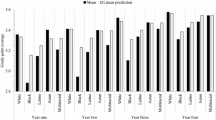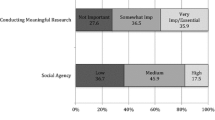Abstract
The purpose of this study is to explore key factors that impact the college transition of aspiring underrepresented minority students in the biomedical and behavioral sciences, in comparison with White, Asian students and non-science minority students. We examined successful management of the academic environment and sense of belonging during the first college year. Longitudinal data were derived from the Higher Education Research Institute’s (HERI) 2004 Cooperative Institutional Research Program (CIRP) Freshman Survey and the 2005 Your First College Year (YFCY) Survey. Using a reformulation of the integration model (Nora, Barlow, and Crisp, 2005), we find concerns about college financing, negotiating family support and responsibility, and campus racial dynamics (perceived and behavioral) affect student adjustment and sense of integration in the first year.

Similar content being viewed by others
References
Allen W. R. (1992) The color of success: African American college student outcomes at predominantly White and historically Black colleges and universities. Harvard Educational Review 62(1): 26–44
Allison P. D. (2002) Missing Data. Thousand Oaks, CA: Sage Publications
Anderson E., Kim D. (2006). Increasing the Success of Minority Students in Science and Technology. Washington, D.C.: American Council on Education
Antonio A. L. (2004). The influence of friendship groups on intellectual self-confidence and educational aspirations in college. Journal of Higher Education 75(4): 446–471
Astin, A. W., and Molm, L. D. (1972). Correcting for Nonresponse Bias in Follow-up Surveys. Unpublished paper. Office of Research, American Council of Education, Washington, DC
Babbie E. (2001). The Practice of Social Research. Belmont, CA: Wadsworth
Bollen K. E., Hoyle R. H. (1990). Perceived cohesion: A conceptual and empirical examination. Social Forces 69(2): 479–504
Bonous-Hammarth M. (2000). Pathways to success: Affirming opportunities for science, mathematics, and engineering majors. Journal of Negro Education 69(1): 92–111
Bonous-Hammarth M. (2006). Promoting student participation in science, technology, engineering and mathematics careers. In: Allen W. R., Bonous-Hammarth M., Teranishi R. T. (Eds.), Higher Education in a Global Society: Achieving Diversity, Equity, and Excellence. Oxford: Elsevier Ltd. (pp. 269–282)
Braxton J. M. (2000). Reworking the Student Departure Puzzle. Nashville, TN: Vanderbilt University Press
Braxton J. M., Milem J. F., Sullivan A. S. (2000). The influence of active learning on the college student departure process: Toward a revision of Tinto’s theory. The Journal of Higher Education 71(5): 569–590
Braxton J. M., Sullivan A. S., Johnson R. M. (1997). Appraising Tinto’s theory of college departure. In: Smart J. (Ed), Higher Education: a Handbook for Theory And Research. New York: Agathon Press (pp. 107–164)
Chang M. J. (1999). Does racial diversity matter? The educational impact of a racially diverse undergraduate population. Journal of College Student Development 40(4): 377–394
Chang M. J., Denson N., Sàenz V., Misa K. (2006). The educational benefits of sustaining cross-racial interaction among undergraduates. The Journal of Higher Education 77(3): 430–455
Chickering A. W., Reisser L. (1993). Education and Identity (2nd Ed.). San Francisco, CA: Jossey-Bass
Dempster A. P., Laird N. M., Rubin D. B. (1977). Maximum likelihood from incomplete data via the EM algorithm. Journal of the Royal Statistical Society 39(1): 1–38
Dey E. L. (1997). Working with low survey response rates: The efficacy of weighting adjustments. Research in Higher Education 38(2): 215–227
Erikson E. H. (1968). Identity: Youth and Crisis. New York: Norton
Farrell E. F. (2002). Engineering a warmer welcome for female students. The Chronicle of Higher Education 48(2/22): A31–A32
Goodchild F. M. (2004). The pipeline: Still leaking. American Scientist 92(2): 112–113
Gurin P., Dey E. L., Hurtado S., Gurin G. (2002). Diversity and higher education: Theory and impact on educational outcomes. Harvard Educational Review 72(3): 330–366
Hoffman M., Richmond J., Morrow J., Salomone K. (2002). Investigating “Sense of Belonging” in first-year college students. Journal of College Student Retention 4(3): 227–256
Hurtado, S. (2007). The sociology of the study of college impact. In Gumport, P. (Ed.), Sociology of Higher Education, Johns Hopkins University Press, Baltimore, MD, pp. 94–112.
Hurtado S., Carter D. F. (1997). Effects of college transition and perceptions of the campus racial climate on Latino college students’ sense of belonging. Sociology of Education 70(4): 324–345
Hurtado S., Carter D. F., Spuler A. (1996). Latino student transition to college: Assessing difficulties and factors in successful college adjustment. Research in Higher Education, 37(2): 135–157
Hurtado S., Cerna O. S., Chang J. C., Sàenz V. B., Lopez L. R., Mosqueda C., Oseguera L., Chang M. J., Korn W. S. (2006). Aspiring Scientists: Characteristics of College Freshmen Interested in the Biomedical and Behavioral Sciences. Los Angeles: Higher Education Research Institute
Hurtado S., Milem J. F., Clayton-Pederson A. R., Allen W. R. (1998). Enhancing campus climates for racial/ ethnic diversity: Educational policy and practice. Review of Higher Education 21(3): 279–302
Keup, J. R., and Stolzenberg, E. B. (2004). Your First College Year Survey: Exploring the Academic and Personal Experiences of First-Year Students, University of South Carolina, National Resource Center for the First Year Experience and Students in Transition, Columbia, S.C
Locks, A., Bowman, N., Hurtado, S., and Oseguera, L. (2006). Extending Notions of Campus Climate and Diversity to the Transition to College: Experiences with Diverse Peers and College Sense of Belonging. Paper presented at the annual meeting of the American Educational Research Association. San Francisco, CA, April, 2006
McLachlan G. J., Krishnan T. (1997). The EM Algorithm and Extensions. New York: Wiley
National Science and Technology Council (2000). Ensuring a Strong U.S. Scientific, Technical, and Engineering Workforce in the 21st century. Washington, DC: Office of Science and Technology Policy
National Center for Education Statistics. (2001). Digest of Education Statistics 2001 (NCES 2001–258). U.S. Department of Education. Washington, DC: U.S. Government Printing Office
Nora A., Barlow L., Crisp G. (2005). Student persistence and degree attainment beyond the first year in college. In: Seidman A. (Ed.). College Student Retention: Formula for Success. Westport, CT: Praeger Publications. (pp. 129–153)
Piaget J. (1985). Equilibration of Cognitive Structures. Chicago, IL: University of Chicago Press
Ruble D. (1994). Developmental changes in achievement evaluation: Motivational implications of self-other differences. Child Development 65(4): 1095–1110
Ruble D., Flett G. L. (1988). Conflicting goals in self-evaluative information seeking: Developmental and ability level analyses. Child Development 59(1): 97–106
Sàenz, V. B., Ngai, H., Hurtado, S. (2007). Factors influencing positive interactions across race for African-American, Asian-American, Latino, and White college students.Research in Higher Education, 48(1): 1–38.
Sax L. J., Hurtado S., Lindholm J., Astin A., Korn W., Mahoney K. (2004). The American Freshman: National Norms for Fall 2004. Los Angeles: UCLA, Higher Education Research Institute
Seymour E., Hewitt N. M. (1997). Talking about Leaving: Why Undergraduates Leave the Sciences. Boulder, CO: Westview Press
Spady W. (1970). Dropouts from higher education: An interdisciplinary review and synthesis. Interchange 1(1), 64–85
Spady, W. G. (1971). Dropouts from higher education: Toward an empirical model. Interchange 2(3), 38–62
Steele C. M. (1997). A threat in the air: How stereotypes shape intellectual identity and performance. American Psychologist 52: 613–629
Sullivan Commission (2004). Missing Persons: Minorities in the Health Professions. Washington, DC: Sullivan Commission on Diversity in the Healthcare Workforce
Thompson M., Sekaquaptewa D. (2002). When being different is detrimental: Solo status and the performance of women and racial minorities. Analyses of Social Issues and Public Policy 2(1): 183–203
Tierney W. G. (1992). An anthropological analysis of student participation in college. Journal of Higher Education 63(6): 603–607
Tinto V. (1975). Dropouts from higher education: A theoretical synthesis of the recent literature. A Review of Educational Research 45(1): 89–125
Tinto V. (1993). Leaving College: Rethinking the Causes and Cures of Student Attrition (2nd ed.). Chicago, IL: The University of Chicago Press
Tinto V. (1997). Classrooms as communities: Exploring the educational character of student persistence. The Journal of Higher Education 68(6): 599–623
Upcraft U. M., Gardner J. N. (1989) The Freshman Year Experience: Helping Students Survive and Succeed in College. San Francisco, CA: Jossey-Bass
Author information
Authors and Affiliations
Corresponding author
Additional information
This study was made possible by the support of the National Institute of General Medical Sciences, NIH Grant Number 1 RO1 GMO71968-01. This independent research and the views expressed here do not indicate endorsement by the sponsor.
Appendix
Appendix
Appendix A: Construction of factors for analyses
Rights and permissions
About this article
Cite this article
Hurtado, S., Han, J.C., Sáenz, V.B. et al. Predicting transition and adjustment to college: biomedical and behavioral science aspirants’ and minority students’ first year of college. Res High Educ 48, 841–887 (2007). https://doi.org/10.1007/s11162-007-9051-x
Received:
Accepted:
Published:
Issue Date:
DOI: https://doi.org/10.1007/s11162-007-9051-x




